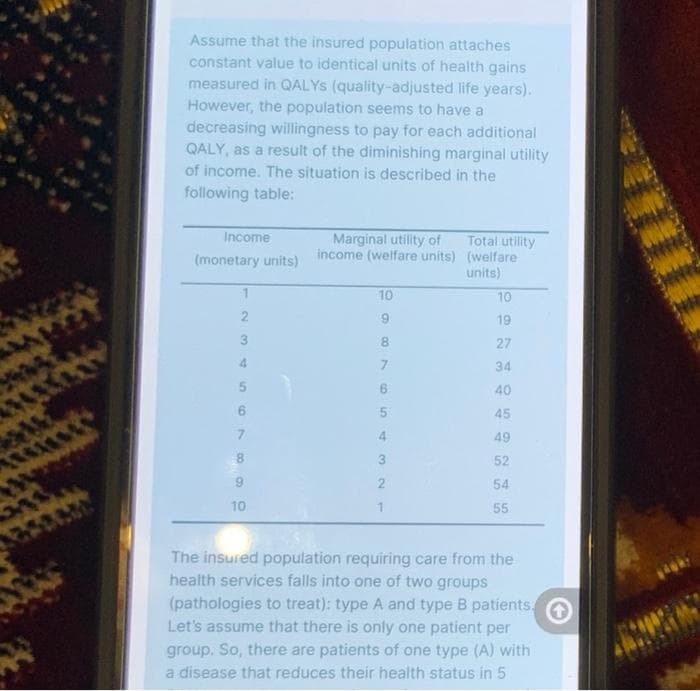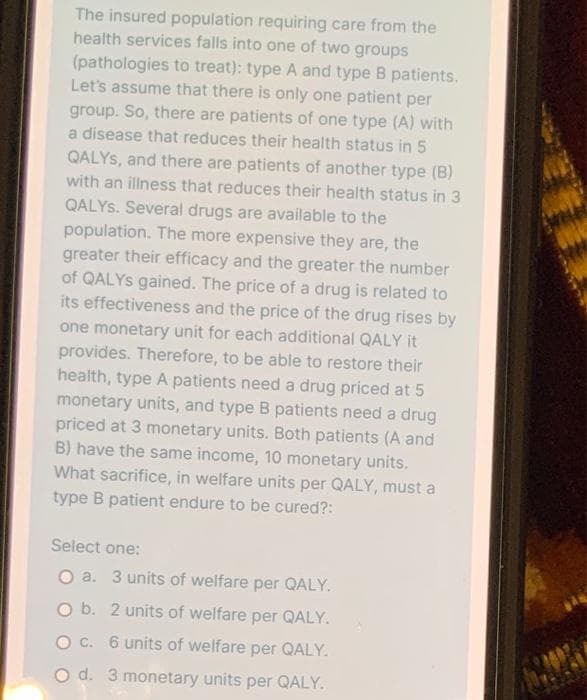Assume that the insured population attaches constant value to identical units of health gains measured in QALYS (quality-adjusted life years). However, the population seems to have a decreasing willingness to pay for each additional QALY, as a result of the diminishing marginal utility of income. The situation is described in the following table: Income Marginal utility of income (welfare units) (welfare Total utility (monetary units) units) 10 10 2 6. 19 8. 27 4. 34 6. 40 6. 45 7. 4. 49 8. 3 52 2. 54 10 55 The insured population requiring care from the health services falls into one of two groups (pathologies to treat): type A and type B patients, Let's assume that there is only one patient per group. So, there are patients of one type (A) with a disease that reduces their health status in 5
Assume that the insured population attaches constant value to identical units of health gains measured in QALYS (quality-adjusted life years). However, the population seems to have a decreasing willingness to pay for each additional QALY, as a result of the diminishing marginal utility of income. The situation is described in the following table: Income Marginal utility of income (welfare units) (welfare Total utility (monetary units) units) 10 10 2 6. 19 8. 27 4. 34 6. 40 6. 45 7. 4. 49 8. 3 52 2. 54 10 55 The insured population requiring care from the health services falls into one of two groups (pathologies to treat): type A and type B patients, Let's assume that there is only one patient per group. So, there are patients of one type (A) with a disease that reduces their health status in 5
Chapter6: Population Health
Section: Chapter Questions
Problem 9QAP
Related questions
Question

Transcribed Image Text:Assume that the insured population attaches
constant value to identical units of health gains
measured in QALYS (quality-adjusted life years).
However, the population seems to have a
decreasing willingness to pay for each additional
QALY, as a result of the diminishing marginal utility
of income. The situation is described in the
following table:
Income
Total utility
income (welfare units) (welfare
units)
Marginal utility of
(monetary units)
10
10
2
9.
19
3
8.
27
4.
34
40
45
7.
4.
49
8.
52
6.
54
10
55
The insured population requiring care from the
health services falls into one of two groups
(pathologies to treat): type A and type B patients,
Let's assume that there is only one patient per
group. So, there are patients of one type (A) with
a disease that reduces their health status in 5

Transcribed Image Text:The insured population requiring care from the
health services falls into one of two groups
(pathologies to treat): type A and type B patients.
Let's assume that there is only one patient per
group. So, there are patients of one type (A) with
a disease that reduces their health status in 5
QALYS, and there are patients of another type (B)
with an illness that reduces their health status in 3
QALYS. Several drugs are available to the
population. The more expensive they are, the
greater their efficacy and the greater the number
of QALYS gained. The price of a drug is related to
its effectiveness and the price of the drug rises by
one monetary unit for each additional QALY it
provides. Therefore, to be able to restore their
health, type A patients need a drug priced at 5
monetary units, and type B patients need a drug
priced at 3 monetary units. Both patients (A and
B) have the same income, 10 monetary units.
What sacrifice, in welfare units per QALY, must a
type B patient endure to be cured?:
Select one:
O a. 3 units of welfare per QALY.
O b. 2 units of welfare per QALY.
O C. 6 units of welfare per QALY.
O d. 3 monetary units per QALY.
Expert Solution
This question has been solved!
Explore an expertly crafted, step-by-step solution for a thorough understanding of key concepts.
Step by step
Solved in 2 steps

Knowledge Booster
Learn more about
Need a deep-dive on the concept behind this application? Look no further. Learn more about this topic, economics and related others by exploring similar questions and additional content below.Recommended textbooks for you

